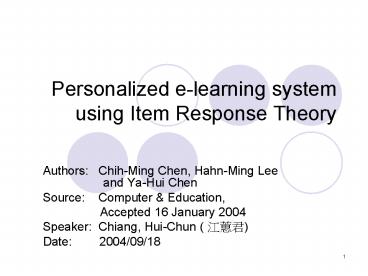Personalized elearning system using Item Response Theory PowerPoint PPT Presentation
1 / 29
Title: Personalized elearning system using Item Response Theory
1
Personalized e-learning system using Item
Response Theory
- Authors Chih-Ming Chen, Hahn-Ming Lee
and Ya-Hui Chen - Source Computer Education,
- Accepted 16 January 2004
- Speaker Chiang, Hui-Chun ( ???)
- Date 2004/09/18
2
Outline
- Introduction
- System designing and implementation
- Experiments and results
- Conclusions
- Comments
- Appendix
3
Outline
- Introduction
- System designing and implementation
- Experiments and results
- Conclusions
- Comments
- Appendix
4
Introduction
- The shortcomings of most personalization systems
- Emphasizing on learner preferences, interests,
browsing behaviors - ?Overload of cognitive
- The rapid growth of information on the Web
- ?Overload of information
5
Introduction
- Improving above drawbacks
- ?Personalized e-learning system using Item
Response Theory (PEL-IRT) - Considering different levels of learners
knowledge - ?Dynamically estimating learners ability based
on the maximum likelihood estimation (MLE) - Considering different course material difficulty
- ?Collaborative voting approach for adjusting the
difficulty
6
Outline
- Introduction
- System designing and implementation
- Experiments and results
- Conclusions
- Comments
- Appendix
7
System designing and implementation
- System architecture
Courses Database
10
User Account Database
Personalized Agent (back-end)
12
2
Courses Recommend- ation Agent
Front-end
User Profile Database
Interface Agent
1
4
5
/ 15
13
14
- Very Hard
- Hard
- Middle
- Easy
- Very Easy
3
11
9
Feedback Agent
7
6
Yes or No
8
8
System designing and implementation
- The learning process of PEL-IRT
9
Outline
- Introduction
- System designing and implementation
- Experiments and results
- Conclusions
- Comments
- Appendix
10
Experiments and results
- Environment Win 2000
- Web server IIS 5.0
- The front-end script language PHP 4.3, MySQL
server - Web-site http//203.64.142.234
- The number of learners logged in the system 210
- The number of user profile database 2525
records - Object learners for Masters degrees and taking
neural networks course
11
Experiments and results
- The entire layout of user interface
12
Experiments and results
- An example of course material recommendation
based on learner ability
13
Experiments and results
- Adjusting the difficulty of course material
14
Experiments and results
- The adaptation of learner ability
15
Experiments and results
- The relationship between learner As ability and
the difficulty parameter of the recommended
course material
16
Experiments and results
- Evaluating degree of satisfaction
17
Experiments and results
- Evaluating the learners responses
18
Outline
- Introduction
- System designing and implementation
- Experiments and results
- Conclusions
- Comments
- Appendix
19
Conclusion
- PEL-IRT
- According to course materials visited by learners
and their responses - Based on learner abilities, providing
personalized recommendations course - Automatically adjusted course difficulty by
collaborative voting - Learners only need to reply to two simple
questionnaires for personalized services
20
Outline
- Introduction
- System designing and implementation
- Experiments and results
- Conclusions
- Comments
- Appendix
21
Comments
- Providing a conscientious method to write papers
- Instead of the questionnaires, using the pretest
and posttest to get the beginners ability, the
experienced users ability and the difficulty of
the course materials
22
- Appendix
23
Operation flowchart of feedback agent
- Three main operations
(1)
(2)
(3)
MLE
Collaborative voting
24
Tuning difficulty parameters of course materials
- Definition 3.1 Difficulty levels of course
material - D D1 , D2 , D3 , D4 , D5
- a set of course material difficulty levels
- where D1 -2 very easy
- D2 -1 easy
- D3 0 moderate
- D4 1 hard
- D5 2 very hard
25
Tuning difficulty parameters of course materials
- Definition 3.2 Average difficulty of the jth
course material based on learner collaboration
voting - b j ( voting ) the average difficulty of jth
course material after learners give collaborative
voting - n i j the number of learners that give feedback
responses belonging to the i t h difficulty level
for the j t h course material - N i j the total number of learners that rate
the j t h course material
26
Tuning difficulty parameters of course materials
- Definition 3.3 The tuned difficulty of course
material - bj ( tuned ) w x bj ( initial ) ( 1 w ) x
bj ( voting ) - bj ( tuned ) the tuned difficulty of the j th
course material based on learner collaborative
voting - bj ( initial ) the initial difficulty of the j
th course material given by course experts - w an adjustable weight
27
Estimation of learner abilities
- Estimating learners ability by MLE
- U j 1 or 0 can or cannot completely
understand the course - P j(?) , Q j(?) the probability that learners
can completely understand the jth course material
at a level below their ability level ?
28
Operation flowchart of courses recommendation
agent
Information function ( Hambleton 1991)
? learner new ability Ij (?) P( a correct
response to the jth course material for learners
with ability ?)
29
Maximum Likelihood Estimation (MLE)
- To determine the parameters that maximize the
probability (likelihood) of the sample data - X1,X2,,Xn are random variables ,
- ? is unknown constant parameters which need to be
estimated - Likelihood function L(?)g(X1,X2,,Xn ? ),
while?? ,let L(?) maximum, then ? is the MLE
of ?

